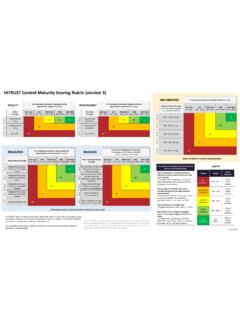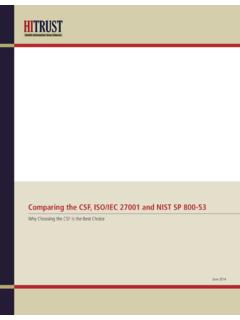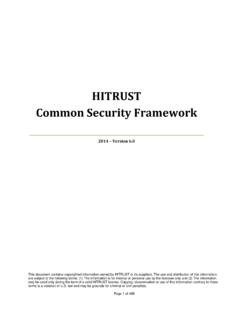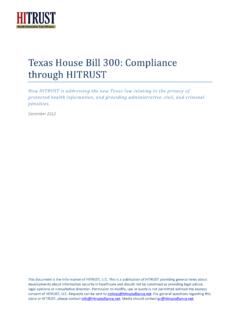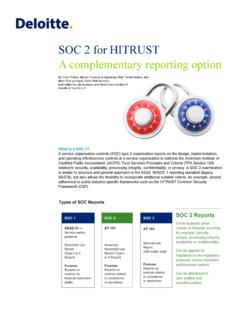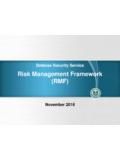Transcription of Risk Analysis Guide for HITRUST Organizations & …
1 Risk Analysis Guide for HITRUST Organizations & Assessors A Guide for self and third-party assessors on the application of HITRUST s approach to risk Analysis February 2018 ContentsPreface ..3 Introduction ..4 HITRUST Risk management framework (RMF) ..5 HITRUST CSF Assessments ..7 HITRUST CSF Control Structure ..8 HITRUST CSF Control Maturity Model ..9 Evaluating Effectiveness ..9 Maturity Approach ..9 Adapting Implementation Specifications for Assessment ..13 Evaluating Requirements Statements ..15 Converting Maturity Scores to the Rating Scale ..21 HITRUST Illustrative Procedures ..23 Final Thoughts ..25 About HITRUST ..26 Appendix A: Risk Treatments ..28 Transference .. 28 Avoidance ..29 Mitigation ..29 Corrective Actions Plans .. 29 Alternate Controls ..34 Acceptance ..40 Appendix B: Frequently Asked Questions ..43 Appendix C: Glossary ..47 Risk Analysis Guide for HITRUST Organizations & Assessors 3<< Back to ContentsPreface The HITRUST Common Security framework (CSF) and CSF Assurance Program provide a consistent, managed methodology for the assessment and certification of healthcare entities and the sharing of compliance and risk information amongst these entities and their key stakeholders.
2 However, to provide the level of consistency and repeatability needed for an industry-accepted framework , both Organizations receiving assessments and the assessors conducting the assessments (either self- or third-party) must fully understand the methodology in order to apply it risk Analysis Guide for HITRUST Organizations and assessors: Provides introductory information on risk management frameworks (RMFs) and the HITRUST RMF, Briefly describes CSF assessments and the CSF control structure, Presents the HITRUST maturity model used to evaluate control effectiveness along with several explanatory examples, Discusses the use of HITRUST s illustrative procedures in conjunction with general criteria for each maturity level, and Provides an appendix on risk treatments, which includes some of HITRUST s views on transference, avoidance, mitigation and acceptance with explanatory examples, including corrective action plan (CAP)
3 Prioritization and alternate control risk of this Guide are expected to have a basic level of knowledge about information security and privacy, risk management and risk Analysis commensurate with holders of the International Information Systems Security Certification Consortium (ISC)2 Health Care Information Privacy and Security Practitioner (HCISPPSM) certification or the HITRUST Certified CSF Practitioner (CCSFP ) credential. Alternatively, readers should review the following documentation prior to using this Guide : HITRUST RMF Whitepaper HITRUST CSF Assessment Methodology HITRUST CSF Assurance Program Requirements Readers may also benefit from reviewing other CSF assessment-related information: Comparing the CSF, ISO/IEC 27001 and NIST SP 800-53 HITRUST MyCSF datasheetsRisk Analysis Guide for HITRUST Organizations & Assessors 4<< Back to ContentsIntroduction The Health Insurance Portability and Accountability Act (HIPAA) Final Omnibus Rule requires covered entities and their business associates (BAs) to implement reasonable and appropriate safeguards to provide adequate protection for sensitive health information.
4 But what constitutes reasonable, appropriate or adequate? Or stated another way, how can an organization select and implement a specific set of controls to manage information security and privacy-related risk at an acceptable level? The textbook answer is through a comprehensive risk Analysis that (1) includes threat and vulnerability assessments, information asset valuation, and the selection of a comprehensive set of information security and privacy controls that address the enumerated threat-vulnerability pairs (a process sometimes referred to as threat modeling), (2) is cost-effective, and (3) manages risk at a level deemed acceptable by the practice, this process is virtually impossible for most if not all Organizations from a quantitative viewpoint. For example, unless actuarial-type information is available, the likelihood a threat-source will successfully exploit one or more vulnerabilities cannot be calculated with any level of precision.
5 In the case of a human actor, likelihood is also dependent on the motivation of the threat source and the difficulty or cost associated with exploiting one or more vulnerabilities to achieve the threat actor s objectives. As a result, it is similarly difficult to develop a valid business case for a specific risk response or treatment based on a return on investment. Organizations could take a semi- or quasi-quantitative approach or even a purely qualitative approach; however, it would still be difficult for an organization especially one in healthcare to develop a valid business case, particularly for a comprehensive set of risk alternative approach is to rely on another organization that does have the resources to develop such a set of controls that addresses similar threats to similar information and technologies used by their own organization . This is the approach employed by the intelligence community (IC), defense department and civilian agencies of the federal government with their respective information security control frameworks, which are currently in the process of being consolidated into a single framework for all federal agencies.
6 It is also the approach used by HITRUST with the CSF, the most widely adopted security framework in the healthcare security control frameworks noted above are also part of a broader risk management framework . For the IC, it was embodied in Director of Central Intelligence Directive (DCID 6/3). For the Department of Defense (DoD), it was the control catalog contained in DoD Instruction (DoDI) combined with other documentation such as the Defense Information Assurance Certification and Accreditation Process (DIACAP) outlined in DoDI For federal civilian agencies, it continues to be the control catalog contained in NIST SP 800-53 r4 and the many publications that make up the NIST Risk management framework . And for government healthcare entities, it includes other NIST resources such as NIST SP 800-66 r1, which provides information on how NIST controls support the HIPAA Security Rule, and the NIST HIPAA Security Rule (HSR) Toolkit.
7 The risk management framework for the broader healthcare industry consists of the HITRUST CSF combined with CSF Assurance Program-related documents and tools, such as the HITRUST CSF Assurance Program requirements, HITRUST CSF Assessor requirements, HITRUST CSF assessment methodology, and HITRUST s comprehensive online tool, Analysis Guide for HITRUST Organizations & Assessors 5<< Back to ContentsHITRUST Risk management framework (RMF) Organizations can use targeted risk assessments, in which the scope is narrowly defined, to produce answers to specific questions .. or to inform specific decisions[,] .. have maximum flexibility on how risk assessments are conducted, .. [and] are encouraged to use [NIST] guidance in a manner that most effectively and cost-effectively provides the information necessary to senior leaders/executives to facilitate informed decisions. (NIST SP 800-30 r1)The HITRUST RMF is a custom framework built around a basic four-step risk management process model designed to meet the specific needs of the healthcare industry.
8 Step 1 Identify risks and Define Protection Requirements The objective of this step is to determine the risks to information and information assets that are specific to the organization . risks can be identified through the Analysis of regulations and legislative requirements, breach data for similar Organizations in the industry, as well as an Analysis of current architectures, technologies, market trends and related threats. The end result of this Analysis should be a prioritized list of high-risk areas and an overall control strategy to minimize the risk to the organization from its use of PHI and other sensitive or business critical information in terms of overall impact to the organization . The HITRUST RMF, through the CSF, rationalizes relevant regulations and standards into a single overarching control framework to help healthcare Organizations meet healthcare clinical and business objectives and satisfy multiple regulatory and other compliance requirements.
9 Step 2 Specify Controls The next step is to determine a set of reasonable and appropriate safeguards an organization should implement in order to adequately manage information security risk. The end result should be a clear, consistent, detailed and prescriptive set of control recommendations that are customized for the healthcare organization . A control-based risk management framework will provide a comprehensive control catalog as well as specific criteria for the selection of a baseline set of controls, which is performed in this step. HITRUST built the CSF to accommodate multiple control baselines, and controls are assigned to specific baselines using three risk factors: organizational type and size ( , a physician practice with fewer than 60,000 visits per year), system requirements ( , the system stores ePHI, is accessible from the Internet, and processes fewer than 6,750 transactions per day), and regulatory requirements ( , subject to FTC Red Flags Rule and PCI-DSS compliance).
10 The result is a healthcare industry-specific baseline, which can be further tailored to an organization s specific clinical, business and compliance Analysis Guide for HITRUST Organizations & Assessors 6<< Back to ContentsStep 3 Implement and Manage Controls Controls are implemented through an organization s normal operational and capital budget and work processes with board-level and senior executive oversight using existing governance structures and processes. A risk management framework will provide guidance and tools for the implementation of the framework , including the controls specified earlier in step trains third party consulting and assessment firms in the CSF and CSF Assurance Program methodologies and tools so that they may offer CSF implementation support, as recommended by OCR, to healthcare provider Organizations that lack the capability to implement and assess information security and privacy controls.
